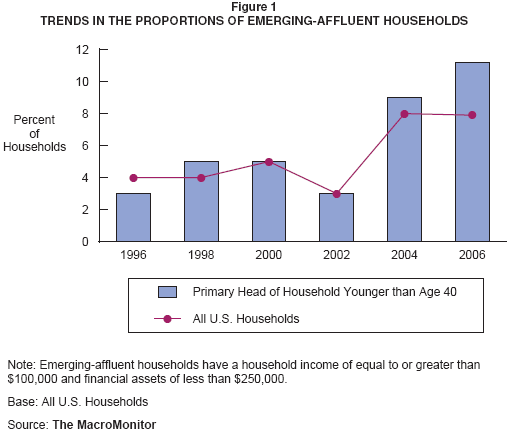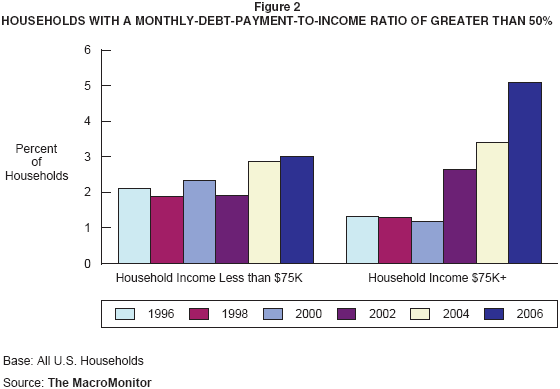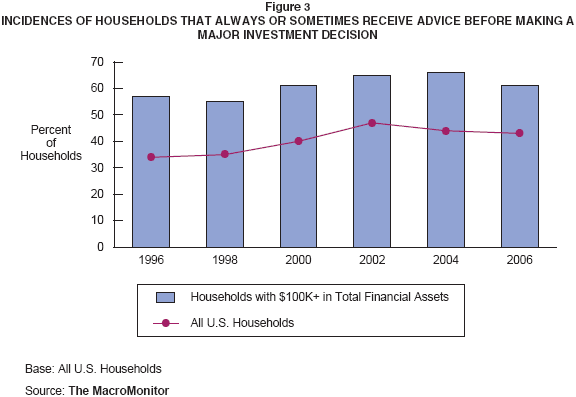MacroMonitor Market Trends August 2008
MacroMonitor Market Trends highlights topical news and trends of interest to you and your colleagues. If you would like more information about the items in the newsletter or would like to discuss other ways that we can assist you in your research and marketing efforts, please contact us.
In this issue:
Cross-Selling and Consolidation Present Challenges and Opportunities for Large Banks
Banks are in a favorable position for cross-selling and organic growth: They tend to have a large number of financial relationships with households and are top of mind in most consumers' financial lives. The 2006–07 MacroMonitor data show that 72% of households identify a bank as their primary financial institution. However, when we look at the percentages of assets held by the various types of institutions, banks fall considerably short of a comparable share of the market. This lower-than-expected share of households' assets by banks likely is attributable to a household's tendency to hold its deposit products at a bank but the lion's share of its assets at a brokerage and in a retirement account outside the household's banking institution. This tendency exists despite the fact that most households express a desire to consolidate their financial assets and simplify their financial lives. The 2006–07 MacroMonitor reveals that 91% of households like to keep their financial affairs uncomplicated—a goal that banks should be well positioned to help consumers meet.
Younger households should be a large target for banks for cross-selling because banks already have a strong foothold with these households through credit and deposit products and because the young households' needs for advice and more varied products will grow as these households mature. Another compelling reason for banks to target the younger age cohort is that among these households is a growing contingent of emerging-affluent households with relatively high incomes though low levels of assets. Banks that can properly position their offerings and create effective messaging for these cohorts stand to reap rewards further down the line.

High-Income Households Witness Steep Growth in Debt-Service Ratio
For most financial researchers and marketers, it comes as no surprise that the debt-service ratio—or the monthly-debt-payment-to-income ratio—in the United States has increased since 1996. Interestingly, however, it is not just lower-income households that are feeling the squeeze of constantly growing debt. Our data show that higher-income households, too, are seeing greater proportions of their monthly income go toward paying debt.
MacroMonitor data reveal that the proportion of U.S. households that pay 50% or more of their monthly income toward debt—including mortgage loans, credit-card balances, consumer loans, and vehicle loans—has increased. This increase has occurred among households at all income levels but, in particular, as Figure 2 shows, among households with an income of $75,000 or more. These households have experienced the steepest growth rate. In 1996, 2.1% of lower-income households (annual income of less than $75,000) had a debt-service ratio greater than 50%: a proportion slightly more than the 1.3% of higher-income households with the same high-debt-service ratio. Fast-forward to 2006, and we see that more than 5% of households with an annual income of $75,000 or more now pay more than half their monthly income toward debt, in comparison with just 3% of households with the lower annual income that do so.
The rapid growth in the proportion of higher-income households that pay more than half their monthly income toward debt is alarming. With basic food and gas prices recently soaring to record heights and with the looming threat of general inflation, these households are living ever closer to bankruptcy—a possible harbinger of more loan defaults and an ever-greater economic downturn.

Hard Times Push Consumers toward Seeking Financial Advice
A ten-year trend of MacroMonitor data shows that consumers' use of financial advisors for help with investment decisions correlates with the overall state of the economy at the time: When economic times are good, use goes down; when economic times are bad, use goes up. In the relatively good financial times of the late 1990s, consumers' use of advice was relatively low. As a result, in 1996 34% of households overall and 57% of households with more than $100,000 in total financial assets reported always or sometimes receiving advice before making a major investment decision. Incidence rose gradually in the years leading up to Y2K—a time during which the markets were retracting—and peaked in 2002 (at 47% and 65%, respectively) after households' portfolios suffered serious blows as a result of 9/11, financial scandals, and the war in Iraq. This period was followed by a brief financial recovery, a time during which home prices and the financial markets soared and use of advice fell off. In 2006, our data show that the incidence of consumers' obtaining advice dropped to 43% of households overall and to 61% of households with $100,000 or more in financial assets.
The two-year period following 2006 (and following the fielding of the previous MacroMonitor survey) has not been rosy. Home values have retracted, home foreclosures have soared, credit has tightened, commodity prices have shot up, and financial markets have taken a beating. Households are mired in debt: They've seen their retirement- and investment-account balances and their home equity decline, and now they face looming inflation. Financial institutions do have a silver lining, however. As a result of these difficult times, they have a unique opportunity to engage consumers while they are particularly receptive, offering guidance and hope for their financial future.
